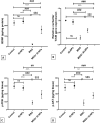Neuroprotective effect of silymarin-loaded nanoliposomes against monosodium glutamate-induced cerebellar motor deficit and Purkinje cell damage in experimental rats via PI3K/AKT pathway activation
- PMID: 40726996
- PMCID: PMC12301764
- DOI: 10.3389/fmolb.2025.1621240
Neuroprotective effect of silymarin-loaded nanoliposomes against monosodium glutamate-induced cerebellar motor deficit and Purkinje cell damage in experimental rats via PI3K/AKT pathway activation
Abstract
Background and aim: This study investigated the ameliorative effect of Silymarin-nanoliposome (SLNPs) against monosodium glutamate (MSG)-induced cerebellar toxicity, illuminating its impact on motor coordination.
Methods: Forty male Wistar albino rats were divided into four groups. Group I (control group): rats received 2 mL of 0.9% NaCl solution; Group II (SLNPs group): rats received SLNPs with a dose of 500 μg/kg bw orally; Group III (MSG group): rats received 3.5 mg/kg bw of MSG intraperitoneally; and Group IV: rats received combined treatment of MSG + SLNPs for ten consecutive days.
Results: MSG-induced cerebellar motor incoordination is represented by increased falls in rats and decreased tow latency spent on the rotarod test. Moreover, MSG altered cerebellar histological structure and significantly (p < 0.05) decreased antioxidant system activity and protein levels of phosphorylated phosphoinositide 3-kinases (p-PI3K), phosphorylated protein kinase B (p-AKT), and brain-derived neurotrophic factor (BDNF). Additionally, there is a decrease in the immunoexpression of nuclear factor erythroid 2-related factor 2 (Nrf2) and gene expression of heme oxygenase-1 (HO-1), tropomyosin receptor kinase B (TrkB), and anti-apoptotic B-cell lymphoma-2 (Bcl-2), alongside an increase in the sera and protein levels of proinflammatory cytokines tumor necrosis factor-alpha (TNF-α), interleukin-6 (IL-6), interleukin-1 beta (IL-1β), immunoexpression of glial fibrillary acidic protein (GFAP), nuclear factor kabba beta (NF-κB), caspase-3, and gene expression of proapoptotic Bax. However, SLNPs prevented MSG-induced cerebellar toxicity, improving motor coordination and morphological structure by enhancing antioxidant, anti-inflammatory, and anti-apoptotic activity by stimulating the PI3K/AKT pathway.
Conclusion: The current study indicated that SLNP administration protects against MSG-induced cerebellar damage, preventing cerebellar oxidative stress, inflammation, and apoptosis, opening the door to examining its clinical use in preventing MSG-induced cerebellar motor incoordination.
Keywords: apoptosis; cerebellar toxicity; monosodium glutamate; neuroinflammation; oxidative stress; silymarin nanoliposomes.
Copyright © 2025 Taha, Alzahrani, Abdelbagi, Bagadood, Qusty, Obaid, El-Nablaway and Baokbah.
Conflict of interest statement
The authors declare that the research was conducted in the absence of any commercial or financial relationships that could be construed as a potential conflict of interest.
Figures









Similar articles
-
The impact of Nrf2/HO-1, PD-L1/Bax/Bcl-2 and TNF-α/Il-6 signaling pathways in the ameliorative role of cordycepin against acrylamide-induced cardiac toxicity in rats.Sci Rep. 2025 Jul 2;15(1):23599. doi: 10.1038/s41598-025-08525-x. Sci Rep. 2025. PMID: 40604049 Free PMC article.
-
Aegeline improves doxorubicin-induced liver toxicity by modulating oxidative stress and Bax/Bcl2/caspase/NF-κB signaling.Sci Rep. 2025 Jul 26;15(1):27203. doi: 10.1038/s41598-025-09675-8. Sci Rep. 2025. PMID: 40715307 Free PMC article.
-
[Mechanism of regulating PI3K-Akt signaling pathway and inhibiting chondrocyte apoptosis to improve inflammation levels in rats with knee osteoarthritis by Shenzhuo Decoction].Zhongguo Zhong Yao Za Zhi. 2025 Jun;50(12):3389-3398. doi: 10.19540/j.cnki.cjcmm.20250213.704. Zhongguo Zhong Yao Za Zhi. 2025. PMID: 40686116 Chinese.
-
A systematic review of p53 regulation of oxidative stress in skeletal muscle.Redox Rep. 2018 Dec;23(1):100-117. doi: 10.1080/13510002.2017.1416773. Epub 2018 Jan 3. Redox Rep. 2018. PMID: 29298131 Free PMC article.
-
NTP Developmental and Reproductive Toxicity Technical Report on the Prenatal Development Studies of 2-((1-(4-Phenoxyphenoxy)propan-2-yl)oxy)pyridine (CASRN 95737-68-1) in Sprague Dawley (Hsd:Sprague Dawley® SD®) Rats and New Zealand White (Hra:NZW SPF) Rabbits: DART Report 07 [Internet].Research Triangle Park (NC): National Toxicology Program; 2022 Jan. Research Triangle Park (NC): National Toxicology Program; 2022 Jan. PMID: 35593777 Free Books & Documents. Review.
References
-
- Abdel-Moneim A. M., Al-Kahtani M. A., El-Kersh M. A., Al-Omair M. A. (2015). Free radical-scavenging, anti-inflammatory/anti-fibrotic and hepatoprotective actions of taurine and silymarin against CCl4 induced rat liver damage. PLoS One 10 (12), e0144509. 10.1371/journal.pone.0144509 - DOI - PMC - PubMed
-
- Abu-Elfotuh K., Abdel-Sattar S. A., Abbas A. N., Mahran Y. F., Alshanwani A. R., Hamdan A. M. E., et al. (2022). The protective effect of thymoquinone Or/And thymol against monosodium glutamate-induced attention-deficit/hyperactivity disorder (ADHD)-Like behavior in rats: modulation of Nrf2/HO-1, TLR4/NF-κB/NLRP3/caspase-1 and Wnt/β-Catenin signaling pathways in rat model. Biomed.Pharmacother. 155, 113799. 10.1016/j.biopha.2022.113799 - DOI - PubMed
-
- Aminuddin M., Partadiredja G., Sari D. C. (2015). The effects of Black garlic (Allium sativum L.) ethanol extract on the estimated total number of purkinje cells and motor coordination of Male adolescent wistar rats treated with monosodium glutamate. Anat. Sci. Int. 90 (2), 75–81. 10.1007/s12565-014-0233-2 - DOI - PubMed
LinkOut - more resources
Full Text Sources
Research Materials
Miscellaneous

